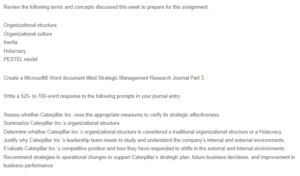Assessing Caterpillar Inc’s Strategic Effectiveness
Assessing whether Caterpillar Inc. is Using the Right Measures to Verify its Strategic Effectiveness
A company’s strategy is effective if it aligns with its goals and offers a good plan to achieve them with available resources. Caterpillar’s CAT strategy revolves around customers, partners, and people. According to the company’s official website, one of its primary strategic objectives is to improve its employees and enable their careers to blossom (Caterpillar Inc., n.d.). The company facilitates this objective by allowing people from diverse cultures to interact, share ideas, and innovate. The company does this to attract the best talent. Due to Caterpillar’s employee improvement strategies, the company was ranked top among America’s top 1000 employers. The company measures the success of this strategy against the top talents it attracts.
Another Caterpillar strategic objective is to bolster future business opportunities. An organization’s financial status may improve or stay in the right direction only if the organization has prospects for future jobs. Caterpillar actively pursues this goal by creating new partnerships and fostering relationships with past clients, among other industry tactics designed to improve an organization’s revenue prospects.
Caterpillar uses the operating and execution model to identify individual areas in the business that could be creating or consuming value (Caterpillar Inc., n.d.). To that end, the company relies on data to determine what areas hold the highest value and what it could take to improve. Henceforth, the company implements strategies that will increase its chances of success.
Summary of Caterpillar Inc.’s Organizational Structure
The company has a structured corporate governance system to ensure it serves all stakeholders with the highest integrity, accountability, and law compliance standards. Caterpillar’s board of directors and global management officers uphold these standards. Caterpillar has ten members on the board of directors, facilitating diverse experiences and individual accountability. Unless there is a conflict, the board of directors convenes annually to discuss policy issues raised by global managers and any other matters. On the other hand, the chief executive officer and other officers make operational decisions.
Why Caterpillar’s Organizational Structure is Considered a Traditional Structure or Holacracy
Caterpillar’s organizational structure is called a holacracy due to its decentralized management. To that end, the decision-making responsibility is distributed among different specialized groups or a holarchy, which is the opposite of hierarchical management (Van De Kamp, 2014). The company adopted a holacracy system in 2015 following a reorganization designed to serve customers’ interests better. The company is subdivided into divisions located in different locations, with each division specializing in its core business segments.
Why Caterpillar’s Leaders Need to Study and Understand the Company’s Internal and External Environment
One of the reasons global leaders study the organization’s internal environment is to realize sustainability. Studying the internal environment helps corporate leaders figure out operations within their areas that lower production (Mangundjaya & Soetjipto, 2014). Henceforth, they can make plans to improve. By studying the internal environment, CAT’s leaders devised a program to recycle older machines called Certified Rebuild. The company has reduced energy waste and enhanced environmental sustainability through the program.
On the other hand, studying the external environment helps the company uphold ethical standards (Mangundjaya & Soetjipto, 2014). Since Caterpillar operates in multiple locations, it sometimes faces novel regulations. For instance, some of the most notable ethical issues affecting the company emanate from the issue of unionized employees.
Caterpillar’s Competitive Position and Its Response to External and Internal Environment Changes
Caterpillar competes in the construction industry and faces high competition from other players who produce similar products. The main competitor is Komatsu, a Japanese manufacturer of mining products. Other major industry competitors include SANY and XCMG.
Caterpillar has responded by providing customer value and support across the globe in response to the changes in external and internal environments. The company strives to meet customer needs regardless of changes in the external environment. For instance, the COVID-19 pandemic caused an economic downturn; hence, the company put in place a plan to sustain its employees.
Strategic Recommendations for Caterpillar Inc.
Caterpillar would benefit by introducing new products to expand its product offers. Currently, the company has limited offers, with competitors like Komatsu offering many products. Diversifying the product range will bolster Caterpillar’s competitive position. Also, the company should consider pursuing a growth and expansion strategy to achieve business sustainability.
References
Caterpillar Inc. (n.d.). Caterpillar | Strategy. Www.caterpillar.com. https://www.caterpillar.com/en/company/strategy-purpose/strategy.html
Mangundjaya, W., & Soetjipto, B. (2014, May). How do the External Environment and Internal Organization Contribute to Commitment to Change? (Study at organizational change in state-owned organizations in Indonesia). In Proceedings of International Academic Conferences (No. 0100006). International Institute of Social and Economic Sciences.
Van De Kamp, P. (2014). Holacracy–A radical approach to organizational design. Elements of the Software Development Process-Influences on Project Success and Failure. University of Amsterdam, 13-26.
ORDER A PLAGIARISM-FREE PAPER HERE
We’ll write everything from scratch
Question 

Assessing Caterpillar Inc’s Strategic Effectiveness
Review the following terms and concepts discussed this week to prepare for this assignment:
Organizational structure
Organizational culture
Inertia
Holacracy
PESTEL model
Create a Microsoft® Word document titled Strategic Management Research Journal Part 3.
Write a 525- to 700-word response to the following prompts in your journal entry:
Assess whether Caterpillar Inc. uses the appropriate measures to verify its strategic effectiveness.
Summarize Caterpillar Inc.’s organizational structure.
Determine whether Caterpillar Inc.’s organizational structure is considered a traditional organizational structure or a Holacracy.
Justify why Caterpillar Inc.’s leadership team needs to study and understand the company’s internal and external environments.
Evaluate Caterpillar Inc.’s competitive position and how they have responded to shifts in the external and internal environments.
Recommend strategies in operational changes to support Caterpillar’s strategic plan, future business decisions, and improvement in business performance.